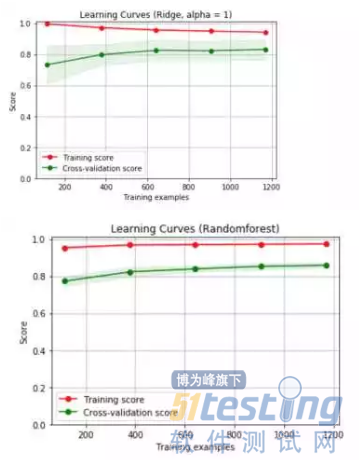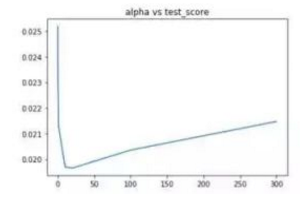5、构建基准模型
from sklearn import cross_validation from sklearn import linear_model from sklearn.learning_curve import learning_curve from sklearn.metrics import explained_variance_score from sklearn.grid_search import GridSearchCV from sklearn.model_selection import cross_val_score from sklearn.ensemble import RandomForestRegressor y = y.values #转换成array数组 X = train_df.values #转换成array数组 cv = cross_validation.ShuffleSplit(len(X),n_iter=3,test_size=0.2) print('岭回归交叉验证结果:') for train_index,test_index in cv: ridge = linear_model.Ridge(alpha=1).fit(X,y) print('train_score:{0:.3f},test_score:{1:.3f}\n'.format(ridge.score(X[train_index],y[train_index]), ridge.score(X[test_index],y[test_index]))) print('随机森林交叉验证结果:') for train_index,test_index in cv: rf = RandomForestRegressor().fit(X,y) print('train_score:{0:.3f},test_score:{1:.3f}\n'.format(rf.score(X[train_index],y[train_index]), rf.score(X[test_index],y[test_index]))) |
哇!好意外啊,这两个模型的结果表现都不错,但是随机森林的结果似乎更好,下面来看看学习曲线情况。
我们采用的是默认的参数,没有调优处理,得到的两个基准模型都存在过拟合现象。下面,我们开始着手参数的调整,希望能够改善模型的过拟合现象。
6、参数调优
岭回归正则项缩放系数alpha调整
alphas =[0.01,0.1,1,10,20,50,100,300] test_scores = [] for alp in alphas: clf = linear_model.Ridge(alp) test_score = -cross_val_score(clf,X,y,cv=10,scoring='neg_mean_squared_error') test_scores.append(np.mean(test_score)) import matplotlib.pyplot as plt %matplotlib inline plt.plot(alphas,test_scores) plt.title('alpha vs test_score') |
alpha在10-20附近均方误差最小
随机森林参数调优
随机森林算法,本篇中主要调整三个参数:maxfeatures,maxdepth,n_estimators
#随机森林的深度参数 max_depth=[2,4,6,8,10] test_scores_depth = [] for depth in max_depth: clf = RandomForestRegressor(max_depth=depth) test_score_depth = -cross_val_score(clf,X,y,cv=10,scoring='neg_mean_squared_error') test_scores_depth.append(np.mean(test_score_depth)) #随机森林的特征个数参数 max_features =[.1, .3, .5, .7, .9, .99] test_scores_feature = [] for feature in max_features: clf = RandomForestRegressor(max_features=feature) test_score_feature = -cross_val_score(clf,X,y,cv=10,scoring='neg_mean_squared_error') test_scores_feature.append(np.mean(test_score_feature)) #随机森林的估计器个位数参数 n_estimators =[10,50,100,200,500] test_scores_n = [] for n in n_estimators: clf = RandomForestRegressor(n_estimators=n) test_score_n = -cross_val_score(clf,X,y,cv=10,scoring='neg_mean_squared_error') test_scores_n.append(np.mean(test_score_n)) |
随机森林的各项参数来看,深度位于8,选择特征个数比例为0.5,估计器个数为500时,效果最好。下面分别利用上述得到的最优参数分别重新训练,看一下学习曲线,过拟合现象是否得到缓解?
再回想一下,我们最初的基线模型学习曲线的形状,是不是得到了一定程度的缓解?OK,下面我们采用模型融合技术,对数据进行预测。
#预测 ridge = linear_model.Ridge(alpha=10).fit(X,y) rf = RandomForestRegressor(n_estimators=500,max_depth=8,max_features=.5).fit(X,y) y_ridge = np.expm1(ridge.predict(test_df.values)) y_rf = np.expm1(rf.predict(test_df.values)) y_final = (y_ridge + y_rf)/2 |
本篇房价预测的模型搭建已经完成。同样,再梳理一边思路:
一、本篇用到的房价数据集存在比较多的数据缺失,且分类变量十分多。在预处理阶段需要将训练集和测试集合并,进行缺失填充和one-hot独热变量处理,保证数据处理过程的一致性,在数据缺失填充过程中,需要综合考虑特征的实际描述和数据的分布,选择合适的填充方式填充;
二、为防止数据变量不统一带来的模型准确率下降,将数值型特征进行标准化处理,数据处理完成后,按照数据合并的方式,再还原到训练集和测试集;
三、先构建岭回归和随机森林基准模型,进行三折交叉验证,绘制学习曲线,存在明显的过拟合现象;
四、接下来分别对两个基准模型进行参数调优,获得使得均方误差最小的参数,返回到训练集进行训练;
五、采用并行模型融合的方式,计算两个模型预测结果的均值作为测试集的预测结果。
上文内容不用于商业目的,如涉及知识产权问题,请权利人联系博为峰小编(021-64471599-8017),我们将立即处理。





















